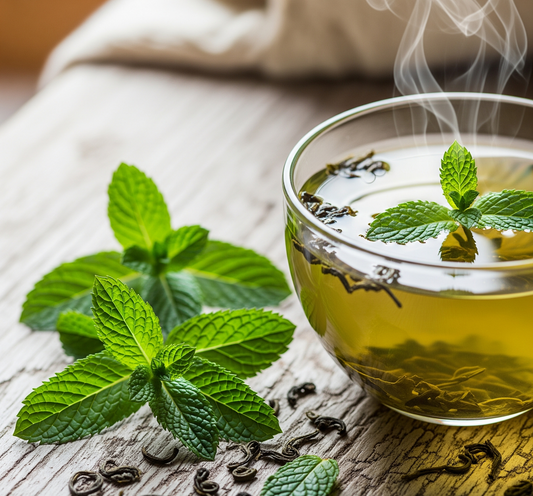Second-flush tea is a captivating choice for tea enthusiasts, harvested in late spring to early summer. Known for its robust flavor and rich aroma, it features muscatel notes and a full-bodied taste. Nepalese varieties, like Kumari Gold, offer unique profiles due to their mineral-rich soil and high-altitude growth, making them stand out in the tea world.
As tea lovers, we naturally learn as much as possible about our favorite beverage. So it isn’t surprising that we would want to learn about first and second flush tea. After all, knowing more about anything allows you to enjoy and appreciate it more intensely - unraveling new layers that would have gone unnoticed.
Second-flush tea is a fascinating topic for tea lovers. If you're curious about what second-flush tea means, you’re in the right place. This unique tea has a flavor profile that many enthusiasts like us adore. So without any further ado, let’s explore the world of second-flush tea.
Let’s start from the basics:
What is Second Flush Tea?
Second flush tea, as the name implies, refers to the second harvest of tea leaves from the same plant. This harvest typically occurs in late spring to early summer, specifically around May to June. The leaves picked during this time are more mature and have developed deeper flavors. This is different from first-flush tea, which is harvested earlier in the year when the leaves are sensitive, tender, and light.
The Characteristics of Second Flush Tea
Perhaps the most prominent distinguishing feature of second-flush teas is their robust flavor and rich aroma. The warmer weather during this period allows the leaves to grow faster and develop more complex characteristics. You’ll often find that second-flush teas have a more full-bodied taste, with muscatel notes and a hint of sweetness. This makes them stand out among other types of tea.
 Nepal Tea Collective’s Kumari Gold for example is a full-bodied, high-quality golden tips second flush tea (Organic Black Tea) with caramel and brown sugar aromas. It is well regarded for its pronounced baked fruit and honey flavors with an earthy, long-lasting finish.
Nepal Tea Collective’s Kumari Gold for example is a full-bodied, high-quality golden tips second flush tea (Organic Black Tea) with caramel and brown sugar aromas. It is well regarded for its pronounced baked fruit and honey flavors with an earthy, long-lasting finish.
Similarly, our Shangri-La Oolong is another second-flush tea that is enjoyed for its mild and naturally sweet taste and aroma that entices the nostrils and satisfies the palates.
In contrast to first-flush teas, which are lighter and more delicate, second-flush teas offer a layered and satisfying depth that many drinkers find more appealing. The color of the second flush tea is also distinct from the first flush. It tends to be darker, often with amber or copper hues that signal its richness.
Why Choose Nepalese Second Flush Tea?
When it comes to second-flush tea, teas from Darjeeling are known the world over. However, Nepalese varieties are also particularly noteworthy and have already started to make waves in the global scene.
Nepal has a unique climate and geography that contribute to the exceptional quality of its teas. The higher altitudes provide cooler temperatures, especially at night, which helps preserve the delicate flavors while allowing for robust growth during the day. Teas like Kathmandu Cosmos, Himalayan Sunrise and Kumari Gold are known and loved for their unique flavors that you won’t find with any other tea.
 Most of the nation’s tea farms are located on top of a unique geographical formation and mountain range called the Siwalik Rock Formation. This one-of-a-kind formation makes the soil rich in minerals like mica, calcium, and magnesium which are absorbed by all the plant life on top of it. This phenomenon helps create a unique nutrient and flavor profile that all Nepalese teas are so famous for.
Most of the nation’s tea farms are located on top of a unique geographical formation and mountain range called the Siwalik Rock Formation. This one-of-a-kind formation makes the soil rich in minerals like mica, calcium, and magnesium which are absorbed by all the plant life on top of it. This phenomenon helps create a unique nutrient and flavor profile that all Nepalese teas are so famous for.
Nepalese second-flush teas often feature a smooth texture and complex flavor profiles that can include hints of fruit, floral notes, and even spices. These teas are not just flavorful; they also carry a sense of place that reflects their mountainous origins.
Nutritional Benefits of Second Flush Tea
As with most organic loose-leaf teas, second-flush teas also offer several health benefits. While they may not have as high antioxidant levels as first-flush teas, they still provide valuable nutrients. As a paper on ScienceDirect mentions, tea comprises several flavonoids, alkaloids, phenolic, theanine, etc that are directly associated with anti-oxidant characteristics and a variety of health benefits.
 The caffeine content in second-flush tea is generally a bit lower compared to first-flush tea, making it a great choice if you’re looking for an afternoon pick-me-up without the jitters. This balance makes it an excellent option for those who enjoy sipping their tea throughout the day.
The caffeine content in second-flush tea is generally a bit lower compared to first-flush tea, making it a great choice if you’re looking for an afternoon pick-me-up without the jitters. This balance makes it an excellent option for those who enjoy sipping their tea throughout the day.
Comparing First Flush vs Second Flush Tea
The debate between first-flush vs second-flush tea often comes down to personal preference. First-flush teas are celebrated for their lightness and floral notes, while second-flush teas make a bold statement with their depth and richness.
If you prefer a refreshing cup that highlights delicate flavors, we recommend going with first-flush tea. However, if you enjoy a more robust experience with complex layers of taste, then second-flush tea is likely to be your favorite.
Other than the different flavor profiles, both teas offer similar drinking experiences and potential health benefits.
You can also read: Which is Better? First Flush versus Second Flush
How to Brew Second Flush Tea
To truly appreciate the complex and robust flavors of second-flush tea, you need to follow some important yet simple steps. The art of brewing tea itself is an experience in itself. To make sure that you experience your tea the right way, we have listed down all the steps for you.
You will need:
- Second Flush Black Tea
- A water kettle
- A teaspoon
- Teacup
- Tea Strainer
- Tea infuser
- Filtered water (Tap water can spoil the flavor)
Step 1: Pour fresh water into the kettle. For a single serving take one cup (180ml)
Step 2: Boil the water between 185ºF to 200ºF and let it calm down.
Step 3: Use 1.5 teaspoons of second-flush loose-leaf tea leaves per cup. Gently mix the leaves with a spoon to make sure all the leaves are soaked in the water.
Step 4: Allow the leaves to steep for 4 to 5 minutes depending on the type of tea you’re using. Note that longer steeping time will make the tea taste bitter and increase the caffeine concentration. We recommend experimenting with the steeping time to find the right taste for your palate.
Step 5: Use a strainer to filter out the tea leaves from the liquor as you pour it into a tea cup.
Step 6: Enjoy the magical flavors of your tea. We recommend not adding milk or sweeteners to experience all the layers of the second flush tea.
In conclusion, second-flush tea offers a delightful experience for those exploring its layered depths. With its robust flavors and rich aromas, this type of tea stands out in the vast world of beverages. Whether you're new to tea or a seasoned enthusiast, trying second-flush tea, especially second-flush teas can open up new horizons in your flavor journey.
FAQs About Second Flush Tea
What makes second-flush tea different from first-flush tea?
Second-flush tea is harvested later (May–June) and has a fuller body, deeper flavors, and muscatel notes, while first-flush tea is lighter, more delicate, and floral.
Does second-flush tea have more caffeine?
Yes, second-flush tea generally has more caffeine than first-flush tea due to the mature leaves, but it’s still milder than many coffee varieties.
Why does second-flush tea have muscatel notes?
The warm weather and longer growing period allow natural fermentation in the leaves, enhancing their signature muscatel, fruity, and caramelized flavors.
How should I brew second-flush tea for the best taste?
Use filtered water at 185ºF–200ºF, steep 1.5 teaspoons of loose-leaf tea for 4–5 minutes, and avoid milk or sweeteners to fully enjoy its layered flavors.
Are Nepalese second-flush teas different from Darjeeling second-flush teas?
Yes! Nepalese teas, like Kumari Gold, grow at higher altitudes with mineral-rich soil, giving them a smoother texture, bold sweetness, and a unique earthiness.
About the Author
Nishchal Banskota is the founder of Nepal Tea Collective, dedicated to offering the finest Nepali teas. With years of experience in the tea industry, Nishchal is passionate about sharing the culture and craftsmanship of Nepali tea with the global tea industry. Learn more about Nepal Tea Collective and explore a variety of award-winning teas that bring you closer to the heart of Nepal.




